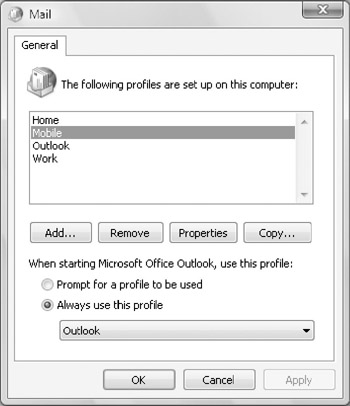Using Mail Profiles to Customize the Mail Environment
The mail profile used with Outlook 2007 determines which information services are available and how they are configured. A default mail profile is created when you install and configure Outlook 2007 for the first time. This mail profile is usually called Outlook.
The active mail profile defines the service setup for the user who is logged on to the computer. You can define additional profiles for the user as well. You can use these additional profiles to customize the user's mail environment for different situations. Here are two scenarios:
-
A manager needs to check Technical Support and Customer Support mailboxes only on Mondays when she writes summary reports. On other days, the manager doesn't want to see these mailboxes. To solve this problem, you create two mail profiles: Support and Standard. The Support profile displays the manager's mail-box as well as the Technical Support and Customer Support mailboxes. The Standard profile displays only the manager's mailbox. The manager can then switch between these mail profiles as necessary.
-
A laptop user wants to check Exchange mail directly while connected to the LAN. When at home, the user wants to use remote mail with scheduled connections. On business trips, the user wants to use Simple Mail Transfer Protocol (SMTP) and POP3. To solve this problem, you create three mail profiles: On-Site, Off-Site, and Home. The On-Site profile uses the Exchange Server service with a standard configuration. The Off-Site profile configures Exchange Server for remote mail and scheduled connections. The Home profile doesn't use the Exchange information service and uses the Internet mail service instead.
Common tasks you'll use to manage mail profiles are examined in the sections that follow.
Creating, Copying, and Removing Mail Profiles
You manage mail profiles through the Mail utility. To access this utility and manage profiles, follow these steps:
-
Start the Mail utility. To do so, click Start, and then click Control Panel. In Control Panel, click User Accounts, and then click Mail.
-
In the Mail Setup–Outlook dialog box, click Show Profiles.
-
As Figure 3-8 shows, you should see a list of mail profiles for the current user. Mail profiles for other users aren't displayed. You can now perform the following actions:
-
q Click Add to create a new mail profile using the Account Settings Wizard.
-
q Delete a profile by selecting it and clicking Remove.
-
q Copy an existing profile by selecting it and clicking Copy.
-
q View a profile by selecting it and clicking Properties.
-

Figure 3-8: To add, remove, or edit mail profiles, click Show Profiles to display this dialog box.
Selecting a Specific Profile to Use on Startup
You can configure Outlook to use a specific profile on startup or to prompt for a profile to use. To start with a specific profile, follow these steps:
-
Start the Mail utility. Click Start, and then click Control Panel. In Control Panel, click User Accounts, and then click Mail.
-
In the Mail Setup–Outlook dialog box, click Show Profiles.
-
After selecting Always Use This Profile, use the drop-down list to choose the startup profile, and then click OK.
To prompt for a profile before starting Outlook, follow these steps:
-
Start the Mail utility. Click Start, and then click Control Panel. In Control Panel, click User Accounts, and then click Mail.
-
In the Mail Setup–Outlook dialog box, click Show Profiles.
-
Select Prompt For A Profile To Be Used, and then click OK.
The user will be prompted for a profile the next time Outlook is started.
EAN: 2147483647
Pages: 119